Key takeaways:
- Recognizing diverse learning needs is essential for creating an inclusive educational environment, enabling emotional connection and engagement among students.
- Implementing personalized learning plans tailored to individual strengths fosters student motivation and ownership of their learning journey.
- Adaptive teaching methods, including technology and flexible grouping, enhance students’ confidence and collaboration, revealing unexpected leaders in the classroom.
- Continuous reflection on teaching outcomes and student feedback is crucial for improving educational practices and ensuring all students feel supported.
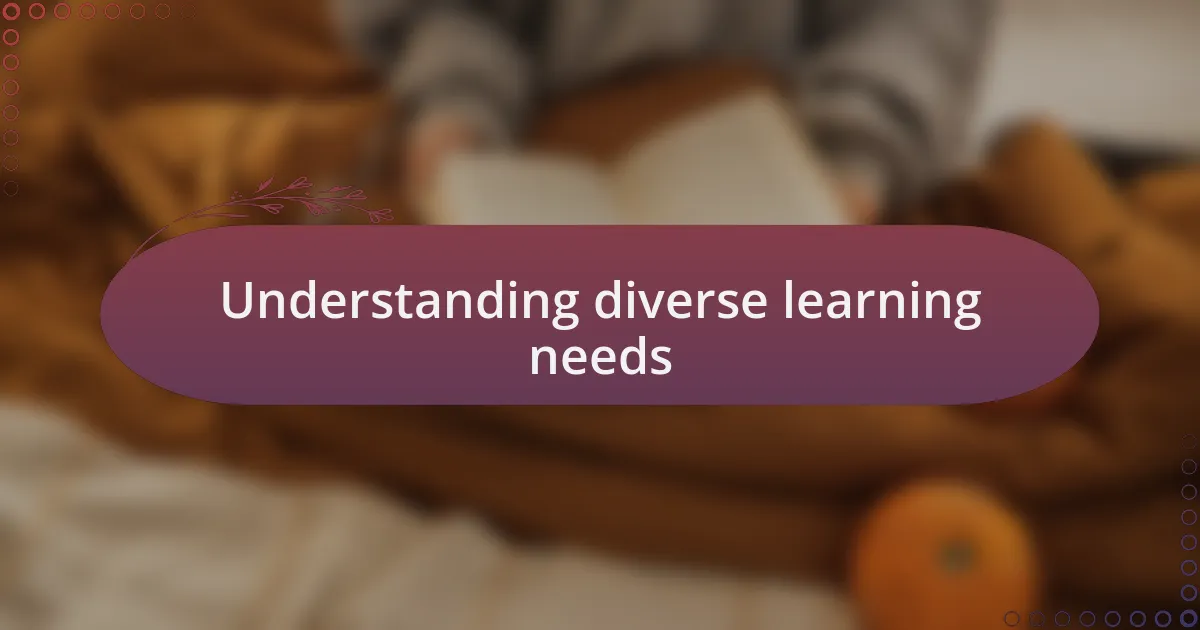
Understanding diverse learning needs
Understanding diverse learning needs is crucial in creating a supportive educational environment. I often reflect on my early teaching experiences when I encountered students who learned differently. One student, for instance, struggled with traditional lecture formats. I realized then that flexibility in my approach was needed to truly address her unique learning style, prompting me to include more visual aids and hands-on activities.
When we talk about diverse learning needs, we must acknowledge the emotional aspect. Have you ever felt frustrated when trying to grasp a concept that just wouldn’t stick? Many students face that same frustration daily. I remember a particular moment when a student’s eyes lit up as they finally understood a concept through group collaboration, highlighting that learning can be as much about connection and emotion as it is about content.
Each learner comes with their own background, experiences, and preferences, creating a rich tapestry of potential in any classroom. How can we harness that potential? I think it starts with observation and a willingness to adapt. By understanding where each student is coming from, educators can better cater to their needs, fostering a more inclusive framework that celebrates diversity in learning.
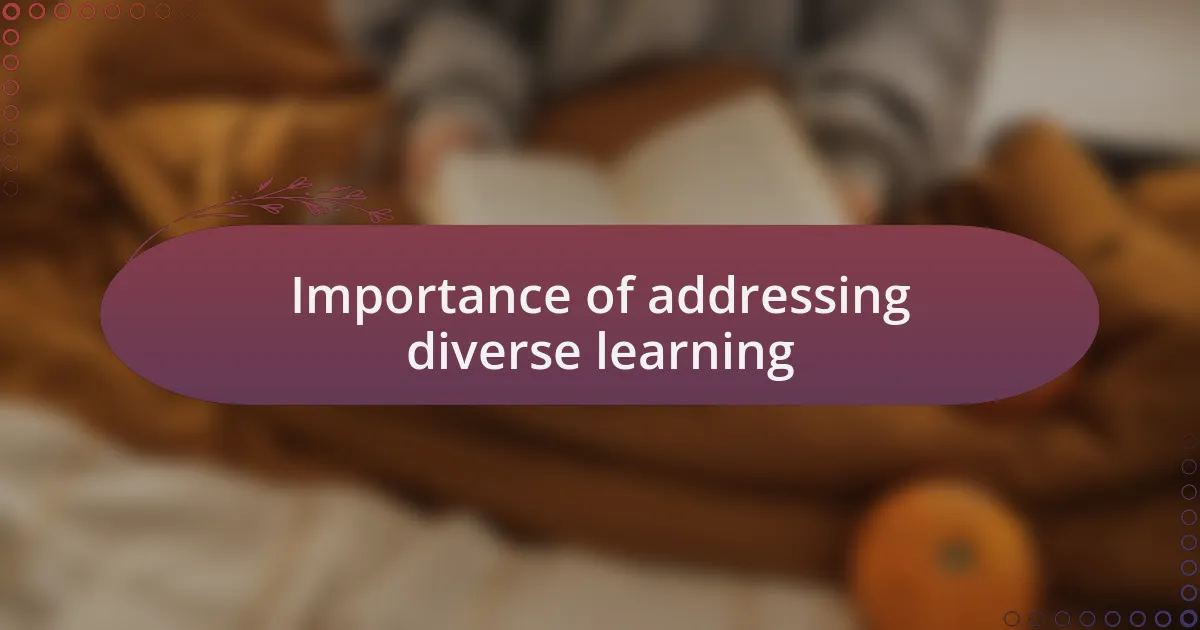
Importance of addressing diverse learning
Addressing diverse learning needs is fundamental to ensuring every student has the opportunity to succeed. I recall a time when I worked with a group of students who had various levels of proficiency in math. By differentiating tasks based on their skills, I observed that those who initially struggled began to gain confidence and take ownership of their learning. That shift not only improved academic performance but also fostered a sense of belonging within the classroom.
The emotional landscape of learning cannot be overlooked. Have you ever witnessed a student who once seemed disengaged suddenly spark with excitement during a project tailored to their interests? I have seen this transformation firsthand. When I incorporated student choices into assignments, the classroom erupted with creativity and energy, proving that when students are connected to the material, their engagement skyrockets.
Moreover, addressing diverse learning needs enhances critical thinking and collaboration skills among students. I remember grouping students with varying strengths and weaknesses to tackle a science project. The discussions that ensued revealed unique perspectives and fostered peer learning. This collaborative approach not only benefited individual students but also enriched the overall classroom experience, demonstrating that diversity isn’t just a challenge; it’s an invaluable resource to enhance learning for everyone.
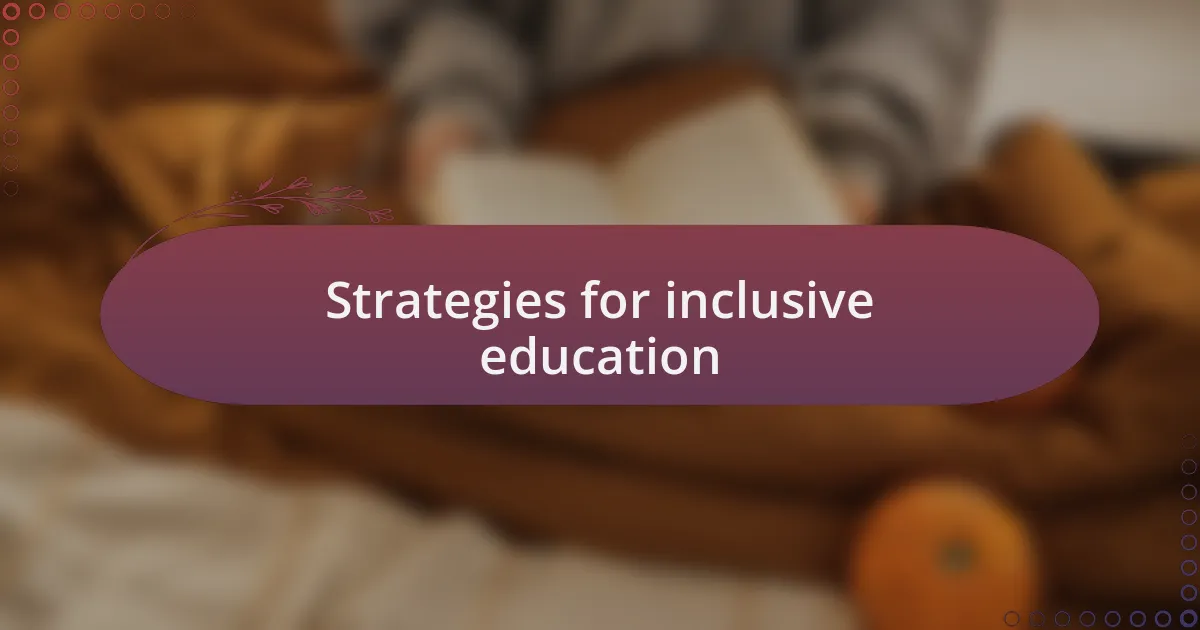
Strategies for inclusive education
Creating an inclusive educational environment requires a toolkit of strategies that embrace the diversity of student needs. One approach I found particularly effective is the use of flexible grouping. When I implemented this during reading sessions, I allowed students to choose their groups based on shared interests. This not only empowered them but created an atmosphere where they could learn from one another, leading to richer discussions and deeper insights. Have you ever felt more comfortable sharing ideas in a group where everyone shares a similar passion?
Incorporating universal design for learning (UDL) principles is another key strategy. I vividly recall a project where I provided multiple means of representing information, such as audio, visuals, and text options. Students were able to engage with the material in a way that resonated with them personally. The excitement in the room was palpable as I witnessed students actively choosing the format that matched their strengths. Can you imagine the satisfaction of learning in a way that feels right for you?
Finally, ongoing formative assessment plays a vital role in inclusive education. By regularly checking in with students, I was able to adjust my teaching methods to better meet their evolving needs. For instance, I used quick surveys to gauge understanding after a lesson, which allowed me to tailor my next steps. This continual feedback loop not only kept me informed but also made students feel heard and valued in their educational journey. How do you think such adjustments could change the dynamics of a classroom?

Assessing student learning styles
Understanding student learning styles is the first step in creating an engaging learning environment. I remember a time when I conducted a simple activity that involved a learning styles inventory. As students reflected on their preferences—be it auditory, visual, or kinesthetic—it sparked fascinating conversations. Have you ever noticed how excited students can get when they begin to understand how they learn best?
To further refine my approach, I incorporated observations and informal assessments into my routine. For example, during a science experiment, I noticed that some students thrived when they could physically interact with the materials, while others preferred to observe and take notes. This moment made me realize the importance of mixing hands-on activities with discussion and reflection. It reinforced the idea that recognizing these diverse styles not only enhances engagement but also fosters a sense of belonging in the classroom.
An effective way to assess learning styles is through discussions and one-on-one check-ins. I often ask students to share how they prefer to learn during these interactions. It’s enlightening to hear their perspectives and preferences, sometimes even leading to surprising revelations. This personalized approach shows students that their voices matter and that I’m committed to supporting their unique learning journeys. What if every teacher prioritized such conversations? Imagine the empowerment that could flourish in educational spaces filled with understanding and care.
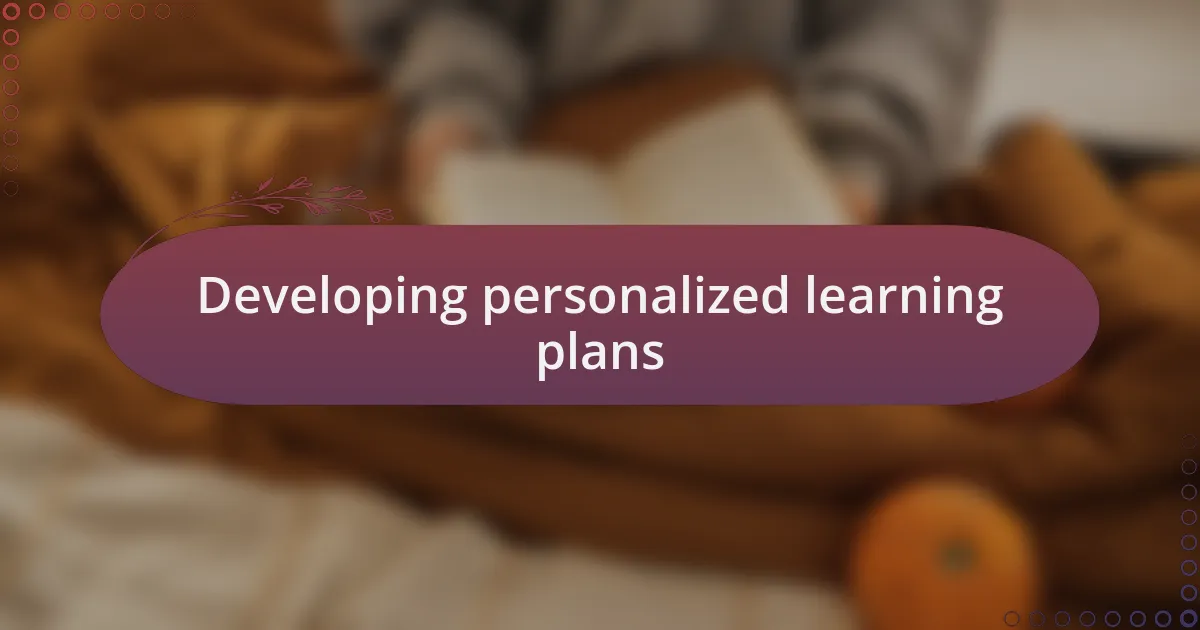
Developing personalized learning plans
Creating personalized learning plans begins with a deep understanding of each student’s unique needs and interests. I once worked with a student named Alex, who struggled with math because traditional methods didn’t resonate with him. By crafting a personalized plan that incorporated visual aids and real-world problem-solving scenarios, I watched him transform from apprehensive to enthusiastic about learning. Have you ever seen a student blossom when provided with the right tools?
Once I started developing these plans, I realized that flexibility is key. One day, I collaborated with a student, Maria, who excelled in art but found writing daunting. By allowing her to express her ideas through illustrations instead of written words, we created a bridge that made writing more accessible and enjoyable for her. It made me wonder: how often do we limit students by sticking to rigid formats rather than exploring their strengths?
Furthermore, involving students in the creation of their own learning plans can be immensely powerful. I remember asking my class to set their own goals, and the excitement was palpable. They took ownership of their learning, and it was rewarding to see how it fueled their motivation. Isn’t it fascinating how empowering students can lead to remarkable growth and independence in their education?
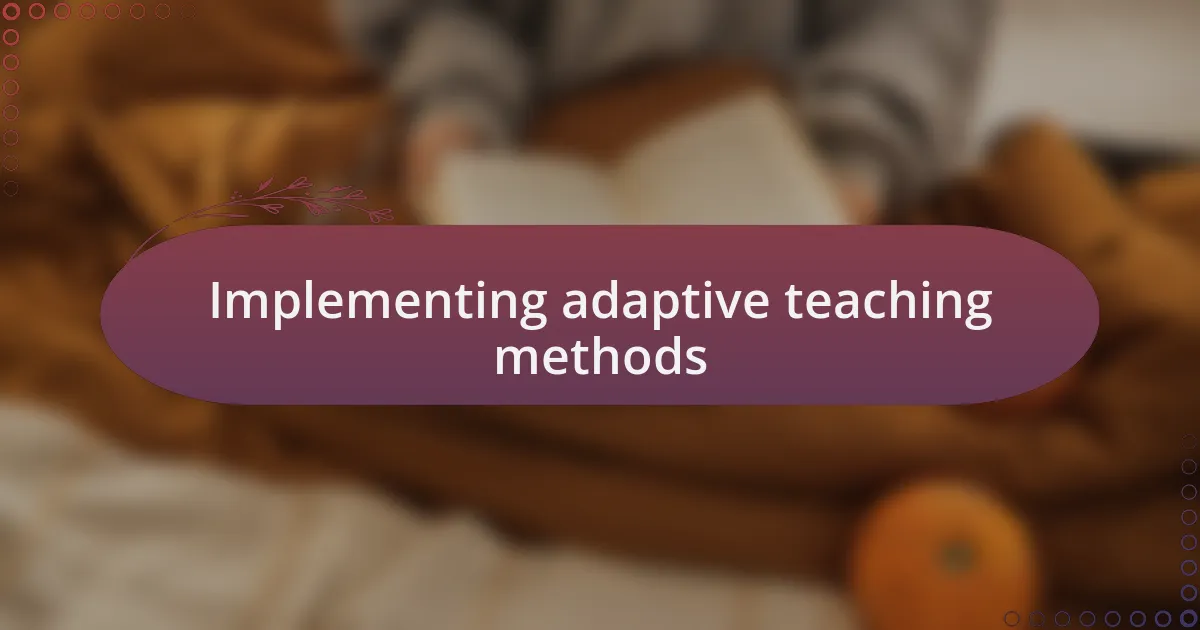
Implementing adaptive teaching methods
Adaptive teaching methods have been a game-changer in my approach to diverse learning needs. I vividly recall a time in my classroom when I introduced technology to assist a student struggling with reading comprehension. By using interactive reading software that adjusted its difficulty based on her performance, I saw a noticeable change in her confidence and ability. Have you considered how technology can enhance your teaching practices?
Moreover, I’ve found that group dynamics can significantly impact adaptive methods. In a recent project, I grouped students with varied skills, allowing them to teach each other. I observed one student, who was usually shy, take the lead in explaining a concept, which not only solidified his understanding but also engaged his classmates. It’s remarkable to think about the unexpected leaders that can emerge in a truly adaptive learning environment, don’t you think?
Ultimately, consistent feedback and ongoing assessment are essential when implementing adaptive teaching methods. I remember introducing quick feedback sessions after each lesson and realizing how they informed my instructional approach. Students appreciated knowing how they were progressing, which sparked discussions on what adjustments could be made. Isn’t it incredible how simple communication can pave the way for more tailored learning experiences?
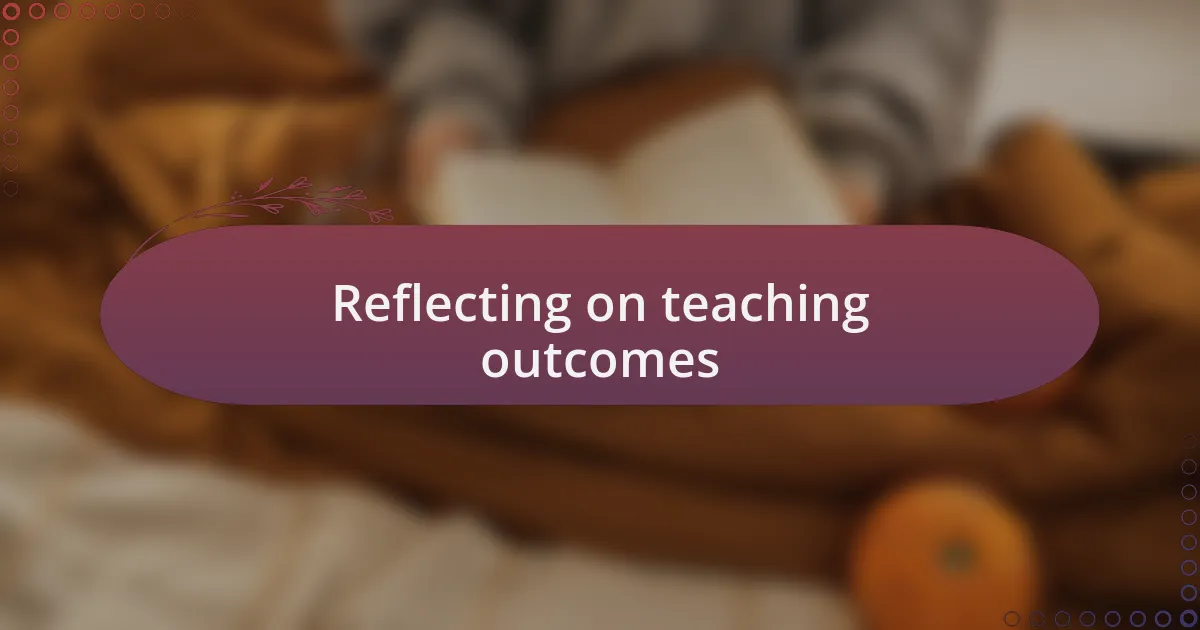
Reflecting on teaching outcomes
Reflecting on teaching outcomes requires a deep dive into both successes and challenges I’ve encountered. For instance, after a particularly interactive lesson, I took some time to assess the students’ grasp of the material. While some students thrived, others showed signs of confusion. I pondered how I could better bridge that gap. Have you ever had a moment when you thought you nailed a lesson, only to realize it didn’t resonate with everyone?
One moment that stands out occurred at the end of a unit when I collected student reflections on their learning experiences. I was struck by the varying perspectives; some found the material engaging, while others felt lost. This contrast compelled me to reconsider my teaching strategies. It’s interesting how deeply students can feel about their learning journey, isn’t it? Their insights often highlight areas where I can adapt to meet their needs better.
Moreover, I’ve embraced the idea of turning reflection into action. After analyzing the feedback, I initiated follow-up sessions that focused on areas of difficulty. I remember one student expressing gratitude for the additional support, stating it made a world of difference. This interaction reinforced my belief that reflecting on outcomes isn’t just about assessment—it’s about fostering growth and connection. How often do we take the time to celebrate these small victories in the learning process?